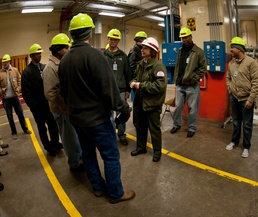
JOINT BASE LEWIS-MCCHORD, Wash. - Senior noncommissioned officers of the 14th Engineer Battalion, Joint Base Lewis-McChord, Wash., traveled to the Cascade Locks, Ore., Nov. 21, to learn the role of the U.S. Army Corps of Engineers in the Pacific Northwest.
The engineers tour started with the original downstream gates of the old Bonneville navigation locks, observed generators inside the powerhouse and finished their tour watching fish swim upstream through the ladders.
Command Sgt. Maj. Leonard Meeks, the battalion command sergeant major, said, “We hear a lot about what the Corps of Engineers does, but now we get to see firsthand how they impact the nation.”
Beginning with a brief history of the locks and dam, Rick Mettler, chief of engineering and contracts at the dam, told the group it originally began in 1824 as a water resource program after the U.S. Congress appropriated money to improve the nation’s river navigation routes.
He noted during that time, the lock was the largest in the world and allowed ships to move cargo upriver, eliminating the need to go around the Cascade Rapids.
Greg Webb, a park and natural resource manager, added that as river traffic increased in the Columbia River, the construction of new dams by 1993 the travel time reduced from several hours to less than 30 minutes.
“The corps started out by constructing forts and navigable waterways,” he said. “As that waterway work evolved, they then built dams and locks, which turned into generation and power elements. This created passageways for vessels and a recreation outlet from the water created around those structures.”
Today, the U.S. Army Corps of Engineers is the federal government’s largest water resource development and management agency. Its purpose is to provide quality, responsive, and cost-effective engineering services to support the nation in peace and war, according to the Army Corps of Engineers website, www.usace.army.mil.
While in the powerhouse, Robin Norris, a natural resource specialist, explained how the dams there provide power to the Northwest region. She said the total generation capacity of the dam is1,084.2 megawatts.
While exploring the facility, Meeks said the tour was valuable as it gave him and his team firsthand knowledge on hydropower and its benefits to the nation and the engineer corps.
As the four-hour tour wrapped up at the fish way ladders, Ben Hausmann, a supervisory fisheries biologist, mentioned one unique job at the dam. He said a worker there counts each of the various species of adult fish that move up the ladder, tracking the runs to research ways fish pass around dams.
“There are between 700,000 and 1.5 million upstream migrant adult salmon and steelhead that pass through Bonneville Dam in an average year,” Hausmann said.
After the tour, participants asked Webb to compare the role of engineers in combat to those working at the Bonneville dam. He stated some of their duties are similar such as fixing floating bridges, conducting land surveys, making maps and preparing detailed plans for construction projects.
“Just as the military has an impact on the nation, in multiple ways so does the Bonneville Locks and Dam Project,” Webb said. “The project delivers a significant amount of power to the region, provides a navigable waterway, creates renewable energy and also generates a revenue from water recreational activities which recycles into the community.”